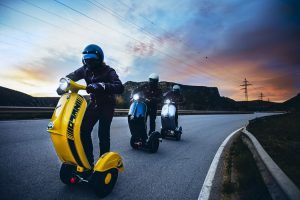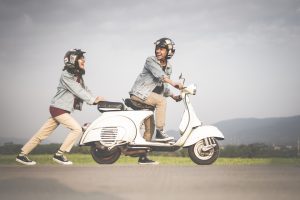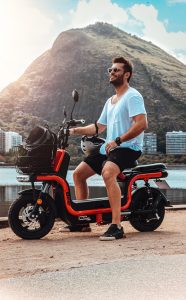Riding scooters uphill can be a thrilling experience, and everyone can understand how important it is for riders to be safe while enjoying the ride.

It’s imperative that we understand the mechanics of our scooters, wear the right protective gear, and know how to check our rides for optimal performance.
Proper body positioning, starting an uphill climb, speed control, and safely stopping or pausing during the ascent are all essential elements of scooter safety.
We can also empower ourselves with knowledge and skills to navigate traffic safely. Not to mention, emergency procedures are crucial to ensure a safe and enjoyable climb.
Remember, the fun is in the journey as much as the destination, especially when that journey is a safe one.
Key Takeaways
- Understanding scooter mechanics and performing regular maintenance is crucial for a smooth and safe uphill ride.
- Wearing proper protective gear, including helmets and knee pads, is essential for preventing injuries during uphill scooter rides.
- Proper body positioning and starting techniques, such as leaning forward and using uphill momentum, are important for a successful uphill climb.
- Navigating traffic, practicing road etiquette, and knowing emergency procedures are essential for a safe and enjoyable uphill scooter ride.
Understanding Scooter
You’ve got to appreciate how your scooter’s mechanics work, as it’s not just about twisting the throttle and zooming uphill – it’s also about understanding the role of the engine, brakes, and tires in ensuring a smooth and safe ride.
Maintenance, particularly keeping the engine well-tuned, is paramount. We’re here to guide you, ensuring your tires are aptly inflated to the optimum tire pressure – an often overlooked, yet essential component. Not only does this provide a smoother ride, but it also significantly boosts your safety.
Let’s not take shortcuts on our scooter’s health, shall we? By taking these steps, we help ensure a safe, enjoyable uphill ride.
Now, let’s not forget about something equally important – the role of protective gear in the safety.

Electric Scooters and Their Capabilities
Most electric ones are designed to handle various terrains, including uphill rides. Riding uphill, however, requires additional considerations to ensure the safety of possible uphill rides. With powerful motors and advanced battery life, e-scooters can tackle steep inclines and provide a convenient mode of transportation for daily commutes or recreational activities.
Choosing The Best Electric Scooter for Climbing Hills
The best electric scooter for tackling steep hills is one with a powerful motor specifically built to climb hills effortlessly. Off-road electric scooters may offer better control in challenging terrains as they are equipped with rugged tires and durable frames. Top speed can be an essential factor when choosing the right e-scooter uphill; however, it’s crucial to prioritize safety features like brakes and overall stability.
Mastering the Art of Riding Uphill on Electric Scooters
When riding an electric one, it’s essential to shift your weight backward slightly while maintaining balance. This action allows better control as you navigate up a steep incline and prevents motor damage due to overloading. It is also important to practice riding on different routes with varying inclines before attempting steeper hills.
Adopting Safe Techniques for Uphill Rides
Safety should always be at the forefront when operating any form of transportation like e-scooters or e-bikes.; this also extends in order to ride an electric one. To avoid accidents while riding hills, brake slowly at first rather than abruptly hitting the brakes so that you can avoid locking up your wheels during descent.
Utilizing Sports Mode When Necessary
Most of them come equipped with multiple modes that cater to specific riding conditions. For example, sports mode is designed explicitly for increased power output which may be needed when climbing steep hills on electric motors. Be cautious, though; using sports mode for too long can put extra stress on the motor and battery life.
Navigating Uphill and Downhill Sections Safely
Riding uphill is only one aspect of the safety of any uphill ride. Equally important is traversing downhill sections with caution. Anticipate turns, maintain a proper speed, and use your brakes conservatively to prevent accidents while riding your electric downhill.
Respecting Local Regulations When Riding Electric Scooters
Different regions have varying regulations regarding e-scooter usage on public roads or sidewalks. Cities like San Francisco are notorious for their hilly terrain, making it essential to follow local laws when riding an electric one uphill or downhill.
Maintaining Your E Scooter’s Health
Regular maintenance of it is crucial not only for safety reasons but also to extend its lifespan. Keep an eye on the motor, brakes, and tires – replace parts as needed to ensure that they continue performing optimally even when tackling steep inclines.
Practicing Proper Etiquette Among Riders
As more people adopt this as a convenient mode of transportation, being respectful towards pedestrians and other riders is vital in ensuring everyone’s well-being within the community.
Understanding the capabilities of electric scooters and prioritizing safety measures when navigating uphill terrains are crucial aspects of ensuring a fun and safe climb. By selecting the best electric scooter with powerful motors designed for climbing hills, following local regulations in your area, and practicing proper etiquette among riders – you’ll be well-equipped for an enjoyable uphill ride experience that prioritizes both fun and safety.
Importance Of Scooter Gears

As we delve deeper into safety, especially when considering scooters with a battery and motor, we can’t stress enough the importance of protective gear. Wearing a helmet isn’t just a good idea, it’s crucial for preventing serious head injuries.
The power and high speeds achieved by these scooters make it even more essential to be properly protected. Likewise, knee and elbow pads are vital for protecting these vulnerable areas during a fall. The weight of the scooter also plays a role in how it impacts the rider during mishaps.
We must all be proactive about our safety and make a pledge to ourselves to never skip out on these potentially life-saving accessories.
Helmet Use
Donning a sturdy helmet isn’t just a safety measure, it’s your personal shield against unpredictable bumps and obstacles on your uphill ride. We can’t stress enough how vital this piece of gear is for your safety.
But it’s not enough to just wear a helmet, it’s crucial to ensure its proper maintenance. A well-kept helmet can significantly reduce the risk of serious head injuries.
We highly recommend visibility enhancements like reflective stickers or bright colors on your helmet. These additions not only add a personal touch but also increase your visibility to others, making your ride safer. Remember, we’re all in this together, striving to create a safer environment for everyone.
Next, let’s discuss the importance of cushioning those joints with knee and elbow pads.
Knee And Elbow Pads
Just like your trusty helmet, knee and elbow pads are your knight’s armor in the modern world of pavement crusades. These essential pieces not only provide protection but also give you the confidence to conquer those uphill rides.
Choosing the right pads is vital, and pad selection should be based on comfort and fit. They should be snug, but not restrictive, allowing you to move freely while keeping you safe.
Pad maintenance is equally important to ensure their longevity and effectiveness. Regularly check for any wear or tear and replace them if necessary. Remember, a well-maintained pad can be a lifesaver in a fall.
Now that we’re geared up, it’s time to focus on ensuring our scooters are in top-notch condition, and ready for the uphill challenge.
Checking Scooter Condition
Before you tackle that uphill ride, let’s make sure your scooter’s in top shape, shall we? It’s essential to prioritize maintenance. Doing this not only guarantees a smoother ride but, more importantly, secures your safety.
Let’s first focus on tire maintenance. Ensure they’re correctly inflated and free of any punctures or wear. Well-maintained tires provide better grip and control, especially when navigating uphill terrains.
Next up is brake inspection. We can’t stress enough how vital functional brakes are. Always check for any signs of damage or wear in the brake pads. Remember, we’re aiming for a fun climb, not a risky one.
Having covered the scooter condition, let’s prepare for the climb itself. Next, we’ll delve into the importance of proper body positioning during your uphill ride.
Proper Body Positioning
Shifting your weight properly can make a world of difference during your ascent, allowing you to maintain control and balance even on steep inclines. Balancing techniques come into play here, as they can significantly increase your riding stability.
Proper body positioning involves leaning forward slightly, keeping your feet firmly on the scooter, and gripping the handlebars with a relaxed, but firm hold.
Visibility enhancement is equally crucial. Position yourself so that other road users can see you clearly, and remember, your safety is paramount. We want to ensure your ride is as enjoyable as it is safe.
In mastering these techniques, you’re setting yourself up for success on your uphill journey. Next, we’ll delve into the best ways to initiate your climb without a hitch.
Scooter Techniques For Uphill Rides
Moving from mastering the art of proper body positioning, let’s now explore the nitty-gritty of initiating your uphill ride. Starting the climb can seem daunting, but with the right techniques, we can ensure a thrilling yet safe ascent.
Firstly, uphill momentum is your best friend. A steady start will give you the necessary push to counteract gravity’s pull.
Secondly, keeping it in top-notch condition through regular maintenance is crucial. A well-tuned scooter ensures a smoother ride and reduces the risk of malfunctions during your climb.
Lastly, always remember to lean forward, this helps maintain balance and enhances your uphill capability.
With these techniques in hand, you’re poised for a successful uphill ride.
Next, we’ll delve into how to navigate sharp turns, an essential skill for a fun and safe ride.
Navigating Sharp Turns For Scooters
Now, let’s tackle those tricky sharp turns, an exciting part of your journey that can give even seasoned riders a real challenge. It’s essential to signal your intentions early – turn signaling isn’t just courteous, but a critical safety measure.
We can’t stress enough the importance of visibility enhancement during these maneuvers. Reflective clothing or lights can be real lifesavers, making you more noticeable to motorists and pedestrians alike.
We understand the thrill of conquering that steep hill, but safety should always come first. Mastering these turns is a testament to your commitment to yourself and others on the road. So let’s continue to place care and safety at the forefront of every ride.
Next, we’ll discuss how to efficiently manage your uphill speed without compromising safety.
Uphill Scooter Speed Control
Mastering sharp turns is only one facet of a safe scooter ride. Managing your speed as you climb demands equal attention. We want you to enjoy the thrill but without the spill. Here’s how:
- Regular scooter brake adjustment is vital. It prevents over-speeding, allowing for a smoother ride.
- Enhancing scooter tire traction aids in maintaining a steady speed, preventing skids on steeper ascents.
- Constant vigilance for quick scooters adapting to sudden changes in incline or terrain.
We care about your safety and fun, especially when riding an electric scooter uphill. Adopting these practices will combine the thrill of the climb with the security of controlled speed. Investing in a high quality scooter with a dual motor can ensure better power and control, especially considering the scooter’s weight and the demands of uphill terrains.
With this knowledge, let’s now address another crucial aspect – how to safely pause or halt your scooter during your uphill ride, ensuring you don’t surpass its maximum speed.
How To Safely Stop Or Pause During Uphill Rides

Pausing or halting your ride midway can be quite tricky, but it’s not impossible if you’ve got the right techniques up your sleeve. Mastering your braking techniques is vital. It’s about applying steady pressure, not jolting the brakes suddenly, to avoid toppling over. We suggest practicing this in a safe, flat area before tackling an uphill climb.
Climbing fatigue is real, and it’s okay to take breaks. Find a flat spot, step off the scooter, and stretch your legs. Remember, safety is our primary concern, not speed.
Dealing With Traffic
Navigating through traffic might seem a bit tricky, but it’s absolutely essential to learn, especially when you’re sharing the road with faster vehicles. We must be mindful of road etiquette at all times to ensure everyone’s safety.
This includes making our intentions clear to other road users, particularly when turning or changing lanes. Signal usage, gesture, or lights, is a crucial part of this communication. It’s not just about protecting ourselves, but also about helping other drivers anticipate our moves, reducing the risk of accidents.
Always remember, we’re not just individuals on the road; we’re part of a community, and our actions affect everyone else.
With this in mind, let’s move on to discuss procedures to follow in case of emergencies, ensuring we’re prepared for any situation.
Scooter Emergency Procedures
Understanding how to respond in an emergency on the road is paramount; it’s worth taking the time now to familiarize yourself with some essential procedures, so you’re ready should the unexpected occur.
We strongly recommend:
- First Aid Training: A crucial skill set for all riders. This training can equip you to handle minor injuries or stabilize more severe situations until professional help arrives.
- Local Red Cross Chapters: They often offer affordable or even free training sessions.
- Online Resources: Many websites provide reliable, comprehensive first aid guides.
- Emergency Contact Information: Having key contacts readily available can expedite help when needed.
- In-phone Emergency Contacts: Store them in your phone for easy access.
- Physical Copy: Keep a written list as a backup.
Remember, preparation is the key to safety. So, take these steps today and enjoy a safer uphill scooter ride tomorrow.
Conclusion
Remember, understanding your scooter’s mechanics, wearing protective gear, and mastering control techniques are crucial for a successful scooter uphill ride. We can’t stress enough the importance of checking your scooter’s condition before each ride, especially considering its speed and power.
It’s essential to make sure your scooter is in the best condition, from the brakes to the battery, before you hit the road. It’s also worth noting how far a scooter can go uphill in terms of its scooter range.
Let’s ensure we’re visible to traffic and prepared for emergencies. Uphill rides can be thrilling, but safety should always come first. So let’s gear up properly, ride responsibly, and enjoy the ascent! Wearing a scooter helmet, elbow pads, and knee pads is key, and learning to lean into the curves will make the ride smoother and more enjoyable.
With the right preparation, an uphill scooter ride can be a fun and safe experience.
Frequently Asked Questions (FAQs):
Can You Use It Uphill?
Certainly, although it’s important to remember that most commuter e-scooters are designed for navigating modest inclines with a hill grade of 10-15%, this corresponds to slopes ranging from 5-10 degrees, akin to a shallow ramp. It’s also crucial to be aware that while ascending, gravity will impede the scooter’s speed, creating challenges in maintaining momentum. So yes, electric scooters can indeed traverse uphill trajectories, but there are various factors you should keep in mind. The climb angle plays an essential role; the steeper the incline, the harder it’ll be for your e-scooter. To effectively maneuver uphill conditions, a scooter should have robust batteries, adequate suspension mechanisms, and high-performance pneumatic tires.
How Do You Keep Away From Accidents When Using It?
Safety measures should begin with investing in quality equipment and insurance coverage for scooters or mopeds. Wearing a helmet is non-negotiable, as well as equipping oneself with proper protective gear and clothing. Being vigilant about potential hazards on the road is crucial, as well as remaining attentive to weather conditions that could impact riding safety. Ensure the security of your scooter or moped by locking it up when not in use and choosing appropriate parking locations. Strict adherence to traffic laws is necessary while maintaining focus on the road and keeping both hands on the handlebars at all times.
Experts recommend inspecting them before each ride, wearing a helmet at all times, riding solo (avoiding tandem rides), and refraining from using your phone while driving. Other essential tips include dressing appropriately for riding conditions, exercising caution on slippery surfaces, maintaining a good grip on handlebars at all times, and adjusting one’s riding style depending on road conditions. Embracing these safety measures can greatly reduce risks associated with usage. Implementing such practices ensures both personal well-being and contributes positively towards overall traffic safety standards.
What Is Hill Grade Scooter?
Basically, a hill grade refers to the steepness or slope of an incline. Typically, electric scooter manufacturers specify the maximum hill grade their products can handle in percentage form (also known as percentage grade). Calculating the relationship between percentage grade and climbing angle may be challenging, though numerous online slope calculators can easily perform these conversions for you.
It’s important to note that as the hill grade increases, so does the steepness of the climb. Most standard commuter electric scooters struggle with slopes featuring a hill grade of 32.5% or an angle of 18 degrees. On the other hand, high-performance e-scooters designed for off-road adventures can effortlessly conquer such inclines. The majority of electric scooters can handle slopes angled between 10 and 15 degrees without difficulty. More powerful models may smoothly ascend angles up to 20 degrees; however, steeper gradients might prove to be too challenging.
Which One Is The Best For Hills?
When considering the ideal one for conquering hills, the Mantis King GT stands out with its remarkable array of functionalities and attributes. Effortlessly tackling any incline, it has established itself as a superior option. For those seeking a scooter below 125cc specifically tailored for hilly regions, the Honda Activa 125 is an excellent choice.
For a more powerful one in challenging terrains and hilly areas, consider those with an engine displacement above 150cc. A prime example of this category would be the Varla Eagle One – its dual 1000-watt motors and full suspension make it an unstoppable force on steep slopes. Besides, Segway Ninebot MAX reigns supreme as the top electric scooter for steep hills due to its industry-leading suspension and acceleration capabilities.
Nevertheless, it depends on factors such as engine size, power output, and suspension systems when evaluating suitability for hilly terrains. Eventually, riders should weigh their personal preferences while considering these factors to make an informed decision on which scooter is best suited for their needs.
What Is The Most Safety Scooter?
Firstly, we have the Ninebot Segway KickScooter ES2. Known for its remarkable durability and design features geared towards keeping riders secure and protected, this scooter is an excellent choice for those prioritizing safety. Next up is the Ninebot Segway KickScooter MAX; another outstanding option from the same reputable brand, boasting even more advanced safety features. Both Ninebot Segway scooters mentioned above provide enhanced security measures designed specifically with rider protection in mind. Similarly, Vespa and Aprilla scooters share similar favorable qualities in terms of road stability during rainy conditions thanks to their weight distribution and power management systems.
How Do You Ride Uphill?
To begin, ensure your feet are firmly positioned on the scooter’s deck while maintaining a balanced and centered stance. As you start ascending, lean forward slightly to shift your weight to the front without going beyond the handlebars to prevent falling forward. Besides, a slight bend in your knees can help lessen your overall weight.
It is crucial to engage your core muscles for added stability during this maneuver. Conversely, when descending a slope, remember to manage the throttle cautiously and apply brakes progressively to enable a smooth downhill ride. By adopting effective body positioning and maintaining control throughout the duration of the ascent or descent, you can master riding it.
Which Is Safer Scooter Or Bike?
Interestingly, it can be equally hazardous as bikes. Both types of vehicles have two wheels and navigate through heavy traffic, which inherently entails certain risks. Although there is no definitive evidence indicating that scooters are safer than bikes, it has been observed that scooter riders tend to engage in less risky behavior compared to their bike counterparts.
Non-riders might perceive scooters as being less dangerous due to their lower top speed, which usually clocks in at around 15 miles per hour for electric models and 50 cc for gas-powered ones. Besides, the way these vehicles handle road imperfections is slightly different – while a scooter’s wheel tends to enter potholes on the road, a bike’s wheel will typically pass over them.
For those reasons, both of them offer their own unique safety features; nevertheless, they both require proper handling and caution of navigating through congested streets. It is crucial for riders of either type of vehicle to be aware of these potential hazards and take necessary precautions for scooting or biking experiences to remain safe and enjoyable. The answer truly lies not just within the vehicles themselves but also with how conscientious the individual rider is when operating them.
What Is The Proper Way To Ride A Scooter?
As a scooter novice, begin gently to familiarize yourself with the vehicle’s handling. When you need to make a turn, simply lean toward the desired direction. To halt, exert equal force on both brakes in unison. A crucial piece of advice from experts is to maintain a defensive riding stance and stay constantly vigilant of your environment.
How Can You Prevent A Scooter Accident?
Yes, by investing in a high-quality one and practicing safe riding habits. Riders should steer clear of rough terrain or uneven surfaces and refrain from operating their scooters during nighttime hours when visibility is low for both riders and motorists. Besides, maintaining reasonable speeds while resisting the urge to weave in and out of traffic lanes are essential factors in preventing potential accidents. By adhering to these recommendations, scooter enthusiasts can keep themselves and others safe on the roads.
Can A 125cc Scooter Go Uphill?
Absolutely! A 125cc scooter is capable of handling most uphill inclines with ease. Utilizing lower gears on the scooter (assuming it’s not a gearless model) can ensure smoother navigation of inclined terrains. So, feel confident embarking on those adventurous hill trips with your trusty 125cc scooter by your side.
DISCLAIMER (IMPORTANT): This information (including all text, images, audio, or other formats on FamilyHype.com) is not intended to be a substitute for informed professional advice, diagnosis, endorsement or treatment. You should not take any action or avoid taking action without consulting a qualified professional. Always seek the advice of your physician or other qualified health provider with any questions about medical conditions. Do not disregard professional medical advice or delay seeking advice or treatment because of something you have read here a FamilyHype.com.